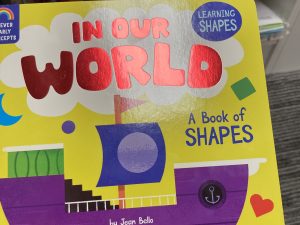Why do you never see a square on the rectangle page of a shapes book for children?

I asked this question of a colleague this summer. It turns out that my colleague and I have different answers to this question. I’ll share both of these answers with you today, then offer evidence for one of them in a future post.
As part of that conversation, my colleague offered a critique of the first page of my own shapes book—Which One Doesn’t Belong? That page is designed to allow orientation as a reason for a shape not to belong. My colleague was mostly worried that I might not have been aware of orientation as a misconception about defining properties of shapes.

The two of us still disagree about whether the book ought to open that way, but my colleague now understands that I made a deliberate and principled choice.
In any case, this disagreement is a more subtle and nuanced version of “Why do you never see a square on the rectangle page?” I now present to you our two theories.
Theory 1: They don’t know the math. This theory holds that the people involved in developing and marketing math concept books for young children do now know that a square is a special rectangle. Most of these people are highly skilled professionals with other areas of expertise. They are talented illustrators, editors, marketers, and storytellers. None of these fields has required them to think hard about formal geometry relationships since they were in high school. Their knowledge of squares and rectangles is cultural, not formal. Therefore existing popular media shape their own understanding, and give them no reason to question it. Rectangles have four sides—two long and two short—and right angles. That’s all there is to know.
Theory 2: They don’t think it matters. In this view, at least one person involved in producing these books does know (and perhaps they all do) that a square is a special rectangle. But they don’t think it’s important to convey this information in resources for young children and their families. There may be a variety of reasons for this belief, which might include the following:
(a) This is first exposure; we can clean up the details later on.
(b) It is too difficult to tell a nuanced story of math relations in a book for young children; there just aren’t enough words available in these short texts.
(c) Children cannot understand this kind of mathematical hierarchy; trying to explain it will confuse them (i.e. it is not developmentally appropriate information for young children.)
One of these is my theory (can you guess which one?) The other is my colleague’s. What do you think?
Hit me up on social media (Twitter, Bluesky, or Instagram), or via the Contact page.
Stay tuned for future posts that elaborate on these themes, and at least one that offers anecdotal evidence for one of these theories (including a recap of a wild conversation I recently had with a person who has some power to help change these things!)
